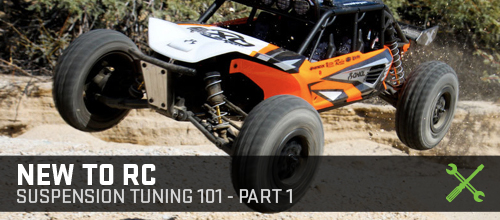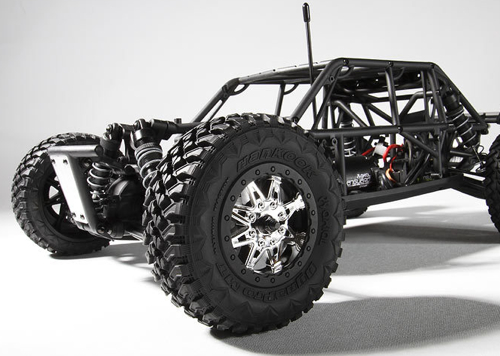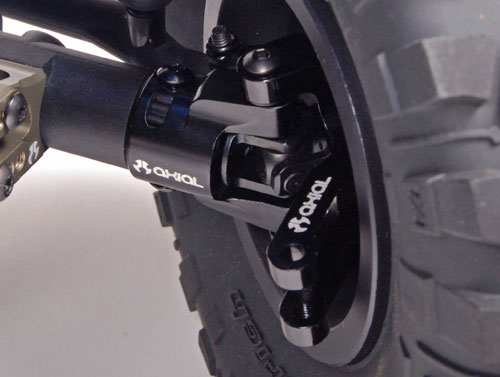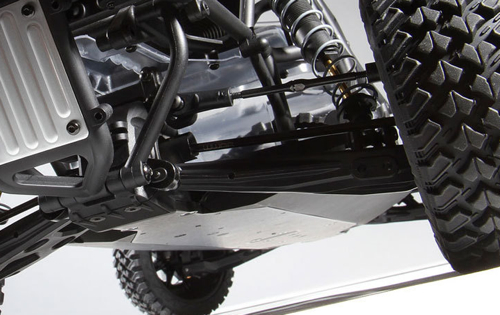Posted: 1/28/13

Most non-enthusiasts have no idea how well engineered hobby-grade RC vehicles are. Take, for example, the Axial Racing EXO Terra Buggy, which has a remarkably sophisticated suspension. To take full advantage of the suspension design, you must understand the key elements.

Camber
Modern RC vehicles (and full-size ones too) with independent suspensions most frequently use a design that employs a lower A-arm with an upper camber link. The RTR EXO uses a fixed camber link and can be upgraded with Axial option parts. The kit version includes an adjustable camber link. Camber is a measurement of how the top of the tire tilts toward or away from the vehicle. Camber is most easily viewed from the front of the vehicle. Camber is measured in degrees and when the top of the tire leans in toward the vehicle it has negative camber. When the top of the tire leans out it is positive camber. Zero degrees of camber is when the tire sits perfectly straight up and down.
Camber is used to increase traction during corning. As a vehicle leans to the outside going through a turn, negative with help the tire have a larger contact patch as the tire leans over. As with just about every suspension adjustment, there is a point of diminishing return, so don’t go overboard and dial in 5 degrees of camber. Adding negative camber to the front suspension will make the vehicle less aggressive and easier to drive. Adding negative camber to the front and rear helps keep the vehicle stable when sliding through rutted surfaces as the edges of the tires will be less likely to grab a rut and roll the vehicle over.

Front Toe
Toe is a steering alignment term that describes how the tires, when viewed from above point in or out. When the front tires point in, the vehicle is said to have toe in. When the tires point out, the vehicle is appropriately said to have toe out. If both front tires are completely parallel to each other, when viewed from above, the vehicle would have zero toe.
Increasing front toe in helps a vehicle track straight. The vehicle wont drift as it’s driven straight without steering input. Toe out usually helps a vehicle with initial turn in. A vehicle with toe out will have quick reacting steering and dive into corners better. Too much toe—in or out—will scrub speed.
Rear Toe
Like front toe, rear toe can be viewed from above and is a measurement of how the tires point in relation to the centerline of the vehicle. Like front toe, rear toe in will help a vehicle track straight and makes it easier to drive. While rear toe out is never used, less rear toe does help a vehicle rotate better in the corners.

Caster
Caster is a measurement of how the front tire’s vertical steering pivot point or axis leans forward or back. Positive caster (negative isn’t used) described how the steering point leans back, so that it isn’t actually perfectly vertical.
Increasing caster helps a vehicle track straight as the positive caster helps straighten the wheels out as the vehicle moves. Adding caster does, however, cause a vehicle to track wide when existing a corner.
Axial’s AR60 axles such as used on the Wraith and Ridgecrest feature an innovative C-hub design that allows for caster adjustments.
Ride Height
Ride height is probably the simplest suspension adjustment to conceptualize. Ride height is a measurement of how high the vehicle sits. Front and rear ride height are separate measurements because they are often set to differently to achieve desired handling.
Ride height obviously impacts ground clearance and increased ride height allows a vehicle to more easily travel over rough terrain. What most people don’t realize is that ride height can influence traction and it does so in a somewhat counterintuitive manner. Increasing ride height raises the vehicle’s center of gravity and actually increases traction because there is more weight transfer. So, if more steering is desired, slightly raising the frontend of the vehicle will increase steering.

Camber Link Position
If you look closely at an EXO you will notice that the upper camber link can be mounted in multiple holes on the outer hub (two on the front hubs and three on the rear hubs) and on the shock tower (four, front and rear). The different holes allow you to run longer or shorter camber links (adjustable links needed) and to change the overall position of the link. It’s working that Axial’s aluminum shock towers offer six mounting positions.
Link length influences what is known as camber change (sometimes called camber rise). To see camber change in action, carefully watch the tires as you compress the suspension by hand. You should notice your camber setting changing as the suspension is compressed. If you shorten the link, camber will increase as the suspension compresses. Longer front links will provide more overall steering. Shorter rear links will help the EXO drive rough, bumpy terrain.
At the shock tower of the EXO, you can raise or lower the link mounting point. This changes the vehicles roll center. The vehicles roll center impacts how much the vehicle rolls to the side during cornering. This is often called body roll. Lowering the inner link mounting locations increases body roll.
Increased front body roll (high roll center/lower inner link position) will make the steering feel more aggressive. Decreased front body roll (low roll center/higher inner link position) will make the vehicle feel more stable. Runner a lower rear link position will add stability over rough, bumpy terrain.